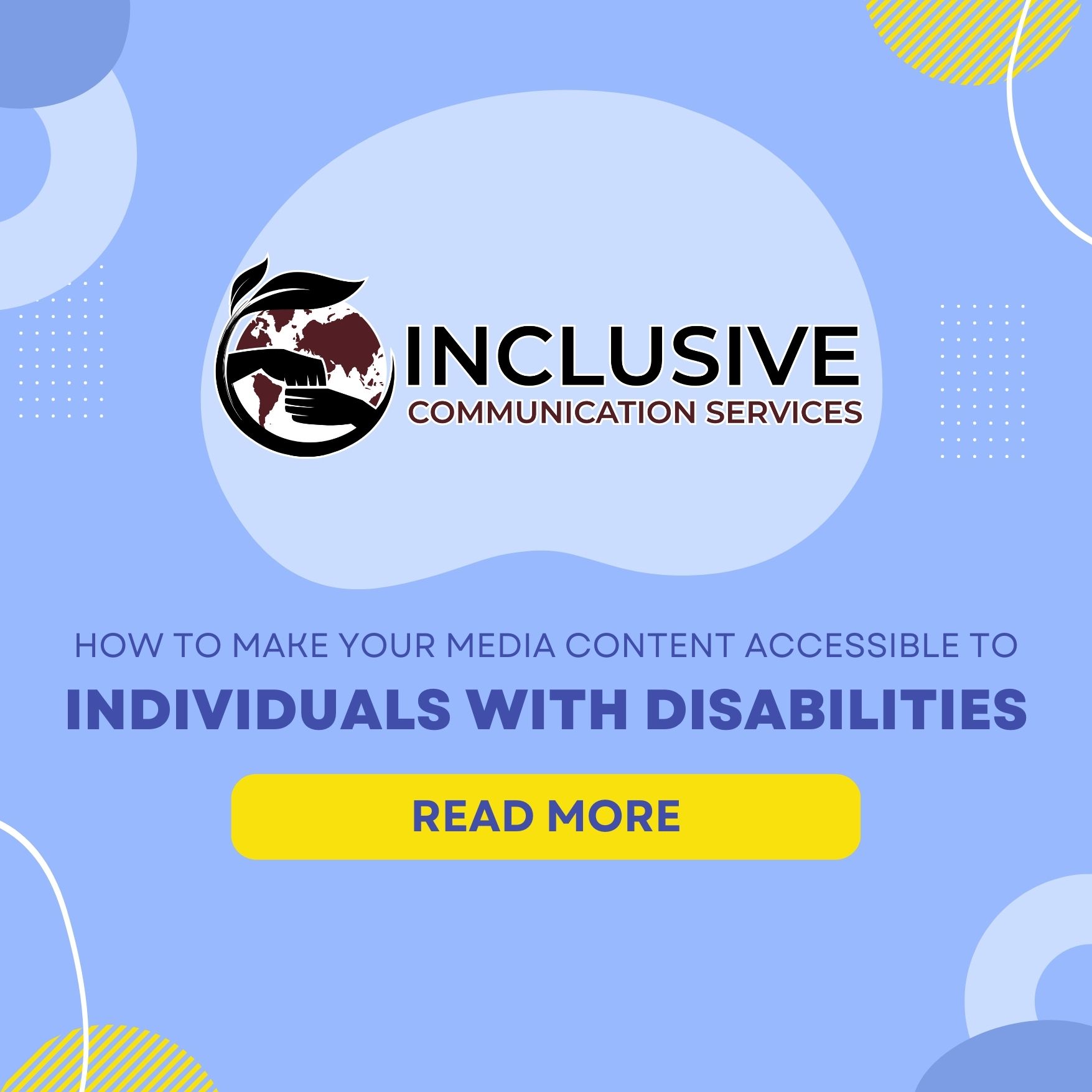We’ve all seen them – we may have even used them – but what are they really?
Media accessibility services make video and audio content accessible through professional closed-captioning, picture-in-picture translation, and audio description. These accessibility solutions make media content accessible to individuals who are Deaf, hard-of-hearing, or blind and provide a crucial resource for ensuring equal access to a diverse audience. Let’s review the media accessibility options available for companies and organizations to implement to make their media content more inclusive.
It is important to note that the accommodations explained here do not only benefit individuals who are Deaf, hard-of-hearing, or Blind. They also benefit broader audiences including the aging, those who speak English as a second language, and those with a learning disability. When a company makes its media content accessible, everyone wins!
Closed-Captioning
One of the most important media accommodations is closed-captioning. Closed-captioning provides a text display of the spoken dialogue, music, and sound effects in a video. It is most appropriate for audiences with hard-of-hearing or late deafened individuals, especially those who do not know American Sign Language (ASL). Closed-captioning allows individuals who cannot hear the audio to still understand the content of the video equal to their hearing peers.
The first step in any captioning service is choosing between closed and open captions. For those who are not familiar, closed-captions can be turned on and off by the viewer according to their preference, while open captions are embedded in the source media and always visible. It is important to consider the target audience and the intended use of the final video, while also recognizing other communities that may rely on this accommodation, such as those who use English as a second language.
The next step is determining the ideal size of the captions and the contrast of the caption font against the font background. This consideration ensures that the caption product is easily readable for individuals with low vision. The customer might also consider adding multilingual captions to ensure equal-access to non-English speaking audiences.
Lastly, it’s important to understand that captions can be transcribed according to different sets of standards, such as WCAG 2.0 vs WCAG 2.1 AA. These standards determine how the captions are organized to display and what information must be captioned. Some standards go as far as defining how many text characters can appear in a single caption line, how to denote a speaker talking off-screen, how to include foreign language content, and how background music and sound effects are denoted. Ultimately, the standard chosen for your media content should be carefully considered alongside any legal or contractual requirements your company or organization has.
When you’re prepared to order caption services for your media content, it’s essential to communicate your requirements and preferences with the service coordinator from the start. A quality service provider, such as Inclusive Communication Services, ensures that the final caption product is tested for quality and accuracy before final delivery.
Sign Language Translation
Another accessibility accommodation that can be integrated into media content is picture-in-picture sign language interpretation. This accommodation is more appropriate for individuals who are congenitally Deaf or who identify with multiple disabilities. With this option, a sign language interpreter provides a simultaneous translation of the audio content for those who cannot hear the source language. You may be familiar with this accommodation from political addresses; however, one difference is that pre-recorded content allows for the signed translation to sync with the source language, whereas live interpreters are often 3-5 seconds behind the source language. The former option provides a higher quality translation and superior equal-access to the media content.
Integrating a sign language translation into media content is a simple process that requires a few considerations. The first consideration in the process is deciding whether the final product should include a picture-in-picture or side-by-side translation. A picture-in-picture translation is placed in a small box within the source video, while a side-by-side translation is placed next to the original video content, typically with similar dimensions. This decision will depend on the intended layout, design, and target audience of the video, as well as the preferences of the production team.
The next consideration is determining the backdrop color for the interpreter’s background. It is important to choose a color that contrasts well with the interpreter’s skin tone and clothing, as well as other elements of the source content, to ensure a clear picture for your audience, particularly those with low vision.
Perhaps most importantly, you should take special consideration when selecting or identifying the qualifications for the recorded translator. This means considering factors such as cultural, linguistic, ethnic, or gender identity or subject matter expertise that ensure the translator is representative of the target audience and is qualified to effectively communicate the content in a manner that is regularly understood by the target audience.
Finally, it is worth considering appropriate attire for the interpreter. The interpreter’s clothing should contrast well with the chosen background to ensure a clear picture and limit strain on the eyes. Aside from the color, the type of attire traditionally depends on what other presenters or actors in the media content are wearing. For example, if all the presenters in a video media are wearing a suit, then it would be appropriate for the interpreter to also wear a suit.
Overall, integrating a sign language interpreter into video media content requires careful consideration of a few factors, including the final layout of the video, ideal background color, the qualifications and demographics of the translator, and the appropriate attire. By making these considerations, companies and organizations can ensure that their media content follows best practices for equal access to individuals who are Deaf or hard-of-hearing.
Audio Description
While closed-captioning and picture-in-picture sign language translation are important accommodations, they are not enough to make a video fully accessible. Individuals who are blind, low-vision, or visually impaired also need accommodations in order to access media content. These accommodations include skillfully arranged color contrasting, increased font sizes, and audio description (AD). Audio Description (AD) is a subtle, simultaneous or time-coordinated dictation of all visual elements in a media, including text, character descriptions, background descriptions, body language, and action. This accommodation allows individuals who are blind or have low-vision to understand the visual elements of a video despite not being able to see them.
Ordering Audio Description (AD) services can be a simple solution to ensuring equal access for your media content. The first step in the process is choosing between paused-coordinated or integrated audio description. Paused-coordinated AD is integrated as a separate audio track that plays during pauses in dialogue or action within the source content. Integrated AD, on the other hand, is heard during natural breaks in dialogue or action and overlapping with the source content, and it is less distinguishable from the original audio.
The next step is choosing between an automated or live voiceover. Automated AD uses software to generate audio descriptions and may sound a little robotic or monotone. The AD is still transcribed by a professional, but the final product is all machine-recorded. Alternatively, live voiceover uses human talent to record the necessary audio description, making the final product sound much more natural, understandable, and distinguishable. It’s important to consider your target audience and the intended use of the final video when making this decision.
If you opt for human voiceover, it’s important to consider factors such as cultural, linguistic, ethnic, and gender identity of your voiceover talent to ensure that the voiceover is representative of the target audience. With this, the customer might also consider adding multilingual audio descriptions to ensure equal-access to non-English speaking, Blind and low-vision audiences. By taking these steps, companies and organizations can ensure that their media content is accessible to individuals who are blind, visually impaired, or who have low vision.
Conclusion
In conclusion, making your video and audio media accessible to the Deaf, hard-of-hearing, and Blind is crucial to ensure that everyone’s equal access and inclusion. Companies and organizations of all sizes and budgets can make their media content accessible by integrating closed-captioning, picture-in-picture sign language interpretation, and audio description solutions. The best approach is to include these accommodations considerations from the start of your production planning. When in doubt, reach out to a trusted community partner like Inclusive Communication Services for advice and guidance or fill out the form below and we will get in touch you.





